1995 Oldsmobile Cutlass Supreme weight
[x] Cancel search: weightPage 79 of 340
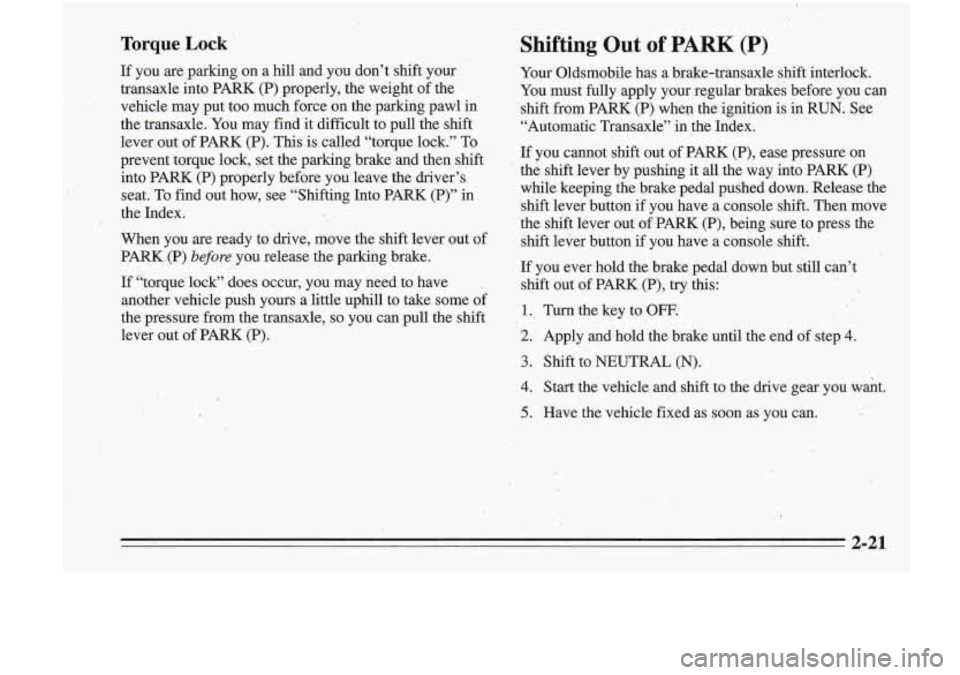
Torque Lock
If you are parking on a hill and you don’t shift your
transaxle into PARK (P) properly, the weight of the
vehicle may put too much force on the parking pawl
in
the transaxle. You may find it difficult to pull the shift
lever out of PARK
(P). This is called “torque lock.” To
prevent torque lock, set the parking brake and then shift
into PARK (P) properly before you 1,eave the driver’s
seat.
To fmd out how, see “Shifting Into PARK (P)” in
the Index.
When you
are ready to drive, move the shift lever out of
PARK (P)
before you release the parking brake.
Shifting Out of PARK (P)
If “torque lock” does occur, you may need to. have ,
another vehicle push yours a little uphill to take some of
the pressdre from the transaxle,
so you can pull the shift .
lever out of PARK (P). Your
Oldsmobile has
a brake-transaxle shift. interlock.
You must fully apply your regular brakes before you can
shift from PARK (P) when the ignition is in RUN. See
“Automatic Transaxle”
in the Index.
If you cannot shift out of
PARK (P), ease pressure on
the shift lever by pushing it all the way into PARK (P)
whil‘e keeping the brake pedal pushed down. Release the
shift lever button if you have a console shift. Then move
the shift lever out
of PARK (P), being sure to press the
shift lever button’
if you have a console shift.
If you ever hold the brake pedal down but still can’t
shift out of PARK (P), try this:
1. Turn the key to OFF.
2. Apply and hold the brake until the end of step 4.
3. Shift to NEUTRAL (N).
4. Start the vehicle and shift to the drive gear you want.
5. Have the vehicle fixed as soon as you can.
2-21
Page 140 of 340
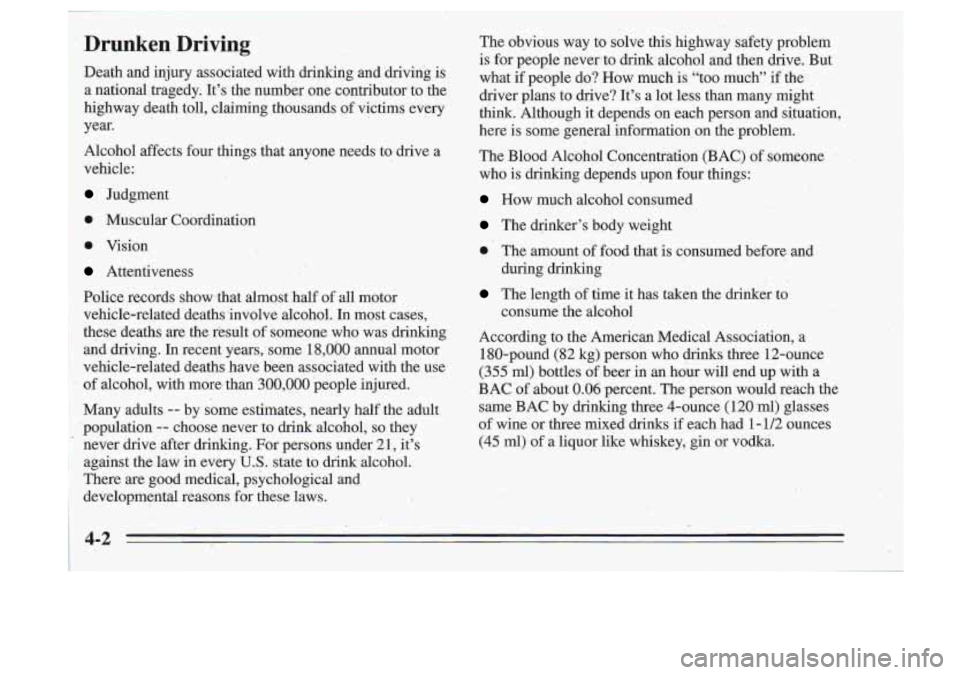
~ ’ Drunken Driving
Death and injury associated with
dnnking and driving is
I a national tragedy.. It’s the number one contributor to the
1 highway death toll, claiming ,thousands of victims every
year.
Alcohol affects four thmgs that anyone needs to drive
a
~ veEcle:
~
Judgment
0 Muscular Coordination
0 Vision
Attentiveness
Police records show-that almost half of all motor
vehicle-related’deaths involve ‘alcohol.
In most cases,
these deaths are the result of someone who was drinking
, ’ and driving. In recent years; some 18,000 annual motor
vehicle-related deaths have been associated with
the use
of alcohol, with more- than
300,000 people injured.
1 Many adults -- by some estimates, nearly half the adult
‘population
-- choose never to drink alcohol, so they
never drive after drinking. For persons under 21, it’s
-against the law in every
U.S. state to drink alcohol.
developmentd reasons for these laws.
i There are good medical, psychological and
,.
The obvious way to solve this highway safety problem
is for people never to drink alcohol and then drive. But
what if people do? How much is “too much” if the
driver plans to drive? It’s a lot less than many might
think. Although it depends on each person and situation,
here is some general information.on the problem.
The Blood Alcohol Concentration (BAC) of someone
who is drinking depends upon four things:
How much alcohol consumed
The drinker’s body weight
0 The amount of food that is consumed before and
during drinking
The length of time it has taken the drinker to
consume the alcohol
According to the American Medical Association, a 180-pound
(82 kg) person who drinks three 12-ounce
(355 ml) bottles of beer in an hour will end up with a
BAC of about
0.06 percent. The,person would reach the
same BAC by drinking three 4-ounce (120 ,ml) glasses
of wine or three mixed drinks if each had 1-1/2 ounces
(45 ml) of a liquor like whiskey, gin or vodka.
, 4-2
Page 164 of 340
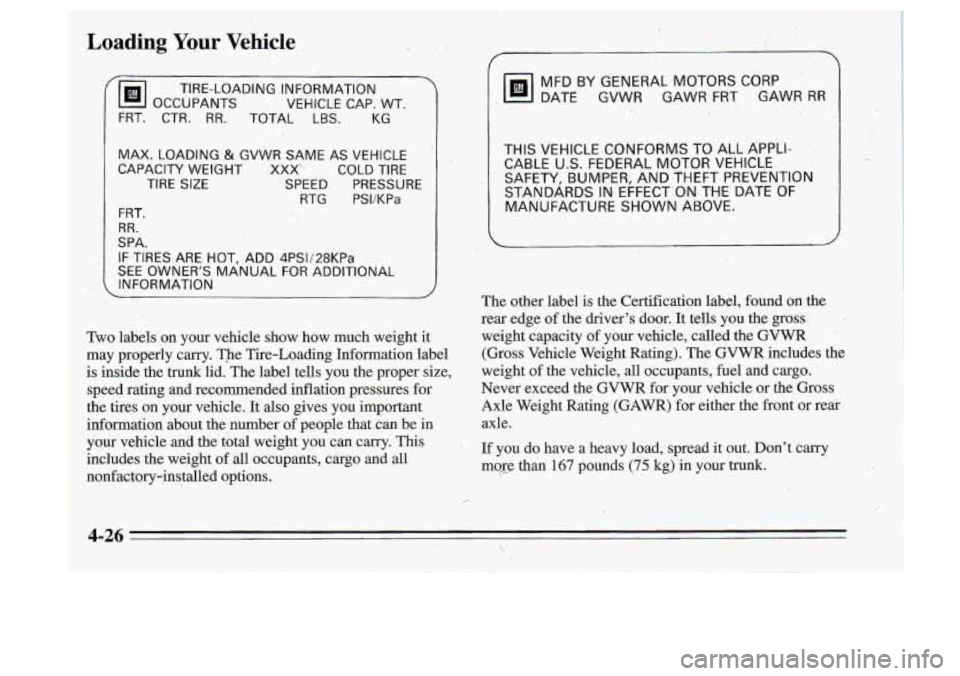
( @ TIRE-LOADING
OCCUPANTS VE’HICLE CAP., WT.
INFORMATION
FRT. CTR.
RR. TOTAL LBS. KG~
I
MAX. LOADING-& GVWR SAME AS VEHICLE
CAPACITY WEIGHT
.XXX’. COLD TIRE
TIRE
SIZE SPEED PRESSURE RTG
PSI/KPa
I
IF TIRES ARE HOT, ADD 4PSI/28KPa
SEE OWNER’S MANUAL FOR ADDITIONAL
INFORMATION
4-26
MFD BY GENERAL MOTORS CORP
THIS VEHICLE CONFORMS TO ALL APPLI-
CABLE U.S. FEDERAL MOTOR VEHICLE
’ SAFETY, BUMPER, AND THEFT PREVENTION
STANDARDS
IN EFFECT ON.THE DATE OF
MANUFACTURE SHOWN ABOVE.
Two labelspn your vehicle show how much weight it
may properly carry. The Tire-Loading Information label
is inside the trunk lid. The label tells you the proper size,
speed rating and recommended inflation pressures for
the tires
on your vehicle. It also gives you important
information about the number‘of people that can be
in
your vehicle and .the total weight you can carry. This
includes the weight of all occupants, cargo and all
--
nonfactory-installed options. The
other 1abel.is the Certification label, found on the
rear edge of the driver’s door.
It tells you the gross.’
weight capacity of your vehicle, called the
GVWR . .
(Gross Vehicle Weight Rating). The GVWR includes the
weight
of the vehicle, all occupants, fuel and cargo.
Never exceed the
GVWR for your vehicle or the Gross
Axle Weight Rating (GAWR) for either the front or re*
axle.
If you do have a heavy load, spread it out. Don’t carry
mop than 167 pounds (75 kg) in your trunk.
Page 167 of 340
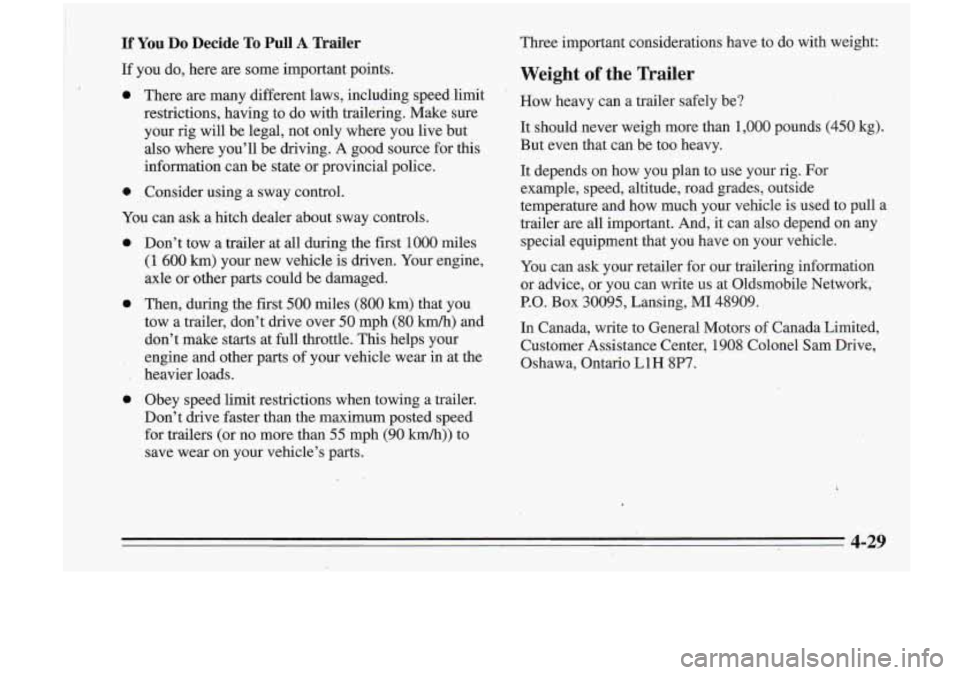
I
I
If You Do Decide To Pull A Trailer
If you do, here are some important points.
0 There are may different laws, including speec i limit
restrictions, having to do with trailering. Make sure
your rig will be legal, not only where you live but
also where you’ll be driving. A good source for this
information can be state or provincial police.
0 Consider using a sway control.
You can ask a hitch dealer about sway controls.
0
0
0
Don’t tow a trailer at all during the first 1000 miles
(1
600 km) your new vehicle is driven. Your engine,
axle or other parts could be damaged.
Then, during
the first 500 miles (800 km) that you
tow a trailer, don’t drive over
50 mph (80 km/h) and
don’t make starts at, full throttle. This helps your
engine and other parts of your vehicle wear in at the
heavier loads.
Obey speed limit restrictions when towing a trailer.
Don’t
drive faster than the’maximum posted speed
for trailers (or no more than 55 mph (90 km/h)) to
save wear on your vehicle’s parts. Three important
considerations have to do with weight:
Weight of the Trailer
How heavy can a trailer safely be?
It should never weigh more than 1,000 pounds
(450: kg).
But even that can be too heavy.
It depends on how you plan to use your rig.
For
example, speed, altitude, road grades, outside
temperature and how much your vehicle is, used to pull
a
trailer are all important. And, it can also depend on any
special equipment that you have on your vehicle.
You can ask your retailer for our trailering information
or advice, or
you can write us at Oldsmobile Network,.
P.O. Box 30095, Lansing, MI 48909.
In Canada, write to General Motors of Canada Limited,
Customer Assistance Center, 1908 Colonel
Sam Drive,
Oshawa, Ontario LlH
8P7.
4-29
I
Page 168 of 340
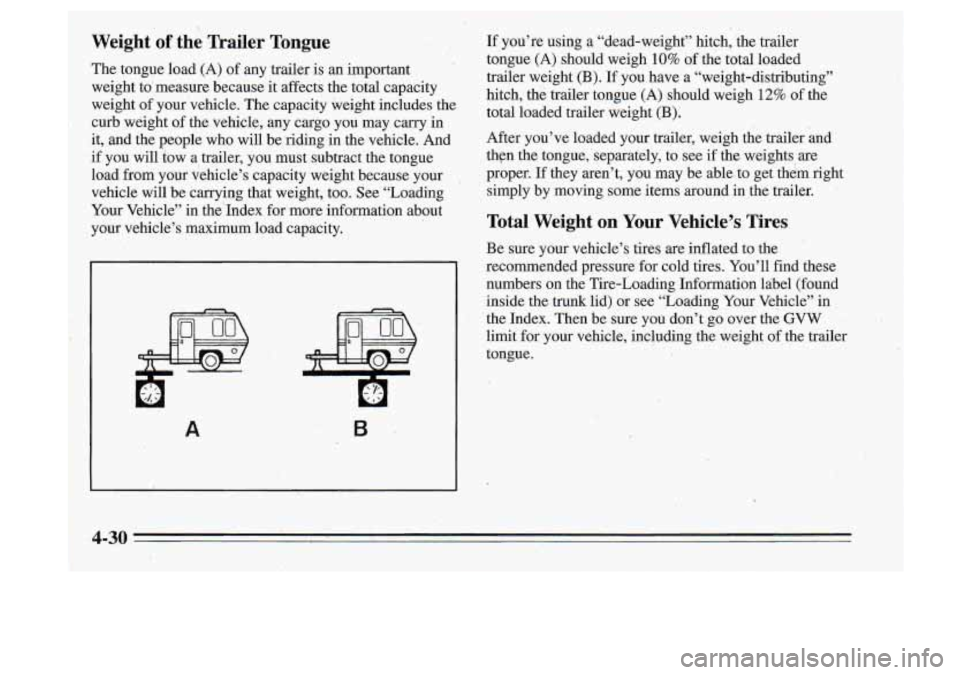
Weight of the Trailer Tongue -. <
The tongue load (A) of any trailer is an important
weight to’ measure because it affects the total capacity
weight
of your‘vehicle. The capaci,ty weight includes the
curb weight
of the vehicle, any cargo you may carry in
it, and the people who will be riding
in the vehicle. And
if you will tow a trailer, you must subtract the tongue
load from your vehicle’s capacity weight because your
vehicle will be carrying that weight, too. See “Loading
Your Vehicle” in the’ Index for .more information about
your vehicle% maximum load capacity.
A
I
Page 170 of 340
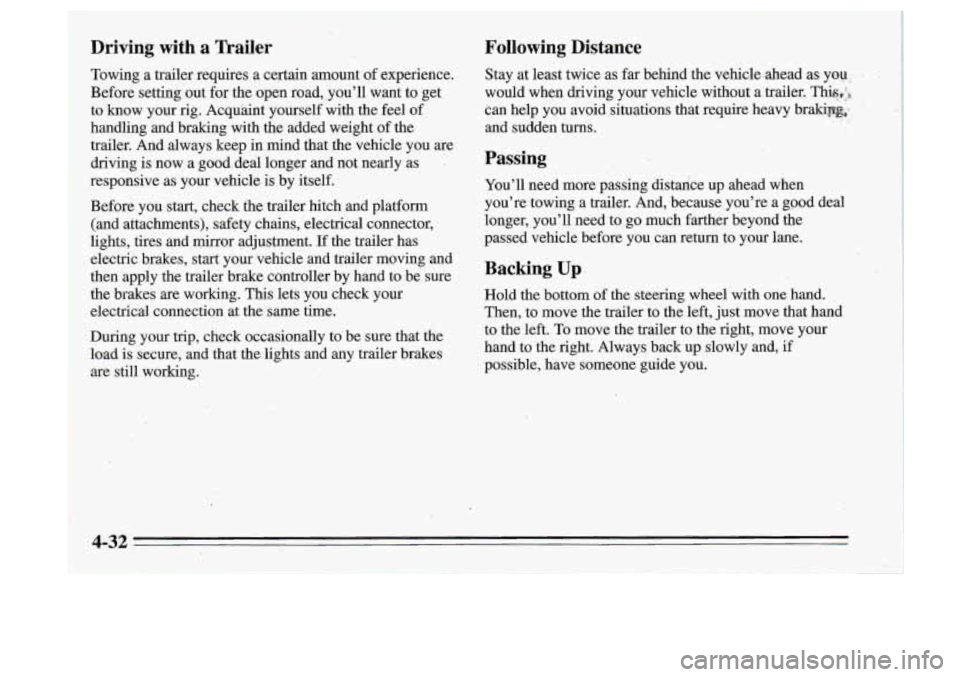
-
I
,'
Driving with a Trailer Following Distance
Towing a trailer requires a certain amount
of experience. Stay at least twice as far behind the vehicle .ahead as- you - .
Before setting out for the open road, you'll want to get would when driving your veh\
icle without a trailer. This$,
to know your rig. AcquQint yourself with the feel of can help you avoid situations that require heavy br-it
and sudden turns.
handling and braking with the added weight of the
trailer. And always keep in mind that ,the vehicle you are
driving is now a good deal longer
and not nearly as . Passing
responsive as your vehicle is by itself. You'll need more passing distance up ahead when
Before you start, check the.trailer hitch and platform you're' towing a trailer. And, because you're a good deal
(and attachments), safety chains, electrical connector, longer, \
you'll need to go much farther beyond the
lights, tires and mirror adjustment.
If the trailer has passed vehicle before you can return to your \
lane.
electric brakes, start your vehicle and trailer moving and
the brakes are working. This lets you check ,your Hold the bottom
of the steering wheel with one hand.
electrical connection at the same time. Then, to move the trailer
to the left, just move that hand
During your
trip, check occasionally to' be sure that the to the left.
To move the trailer to the right, move your
load is secure, and that the lights and any trailer brakes hand to the right. Always back up slowly and, if
are still working. possible. have someone guide you.
.. . ~.
then apply the trailer brake controller by hand to be sure Backing Up
?'
Page 331 of 340
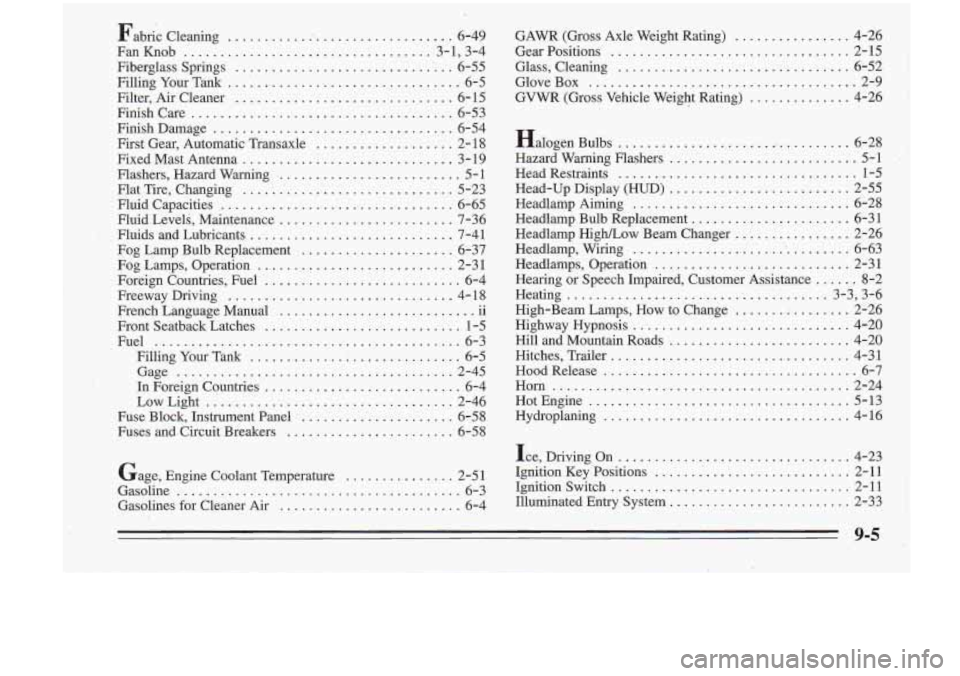
Fib& Cleaning ............................... 6-49
FanKnob
.................................. 3.1. 3.4
Fiberglass Springs
............................... 6-55
Filling Your Tank
... ............................ 6-5
Filter. Air Cleaner
.............................. 6- 15
Finishcare
.................................... 6-53
Finish Damage
................................. 6-54
First Gear. Automatic Transaxle
................... 2-18
FixedMastAntenna
............................. 3-19
Flashers. Hazard Warning
......................... 5-1
Flat Tire. Changing
............................. 5-23
Fluid Capacities
................................ 6-65
Fluid Levels. Maintenance
........................ 7-36
Fluids
and Lubricants ............................ 7-41
Fog Lamp Bulb Replacement
....................... 6-37
Fog -Lamps. Operation
........................... 2-3 1
Foreign Countries. Fuel ....... ................... 6-4
Freeway Driving
............................... 4- 18
French Language Manual
11
Front Seatback Latches ........................... 1-5
Fuel
.......................................... 6-3
Filling Your Tank
............. : ............... 6-5
Gage
...................................... 2-45
In Foreign Countries ........................... 6-4
Fuse Block, Instrument Panel
..................... 6-58
Fuses and-Circuit Breakers
................. ....... 6-58
.. ...........................
LowLight ................................... 2-46 GAWR
(Gross Axle Weight Rating)
................. 4-26
Gear Positions
................................. 2-15
Glass. Cleaning
................................ 6-52
Glove Box
...................................... 2-9
GVWR
(Gross Vehicle Weight Rating) .............. 4-26
Halogen Bulbs
................................. 6-28
Hazard Warning Flashers
.......................... 5-1 .
Head Restraints ................................. 1-3
Head-Up Display
(HUD) ......................... 2-55
Headlamp Aiming
.............................. 6-28
Headlamp Bulb Replacement
...................... 6-31
Headlamp HighLow Beam Changer
................ 2-26
Headlamp. Wiring
............................... 6-63
Headlamps. Operation
........................... 2-31
Hearing or Speech Impaired. Customer Assistance
...... 8-2
Heating
....................................... 3-3., 3-6
High-Beam Lamps. How to Change
....... .. ........ 2-26
Highway Hypnosis
............................... 4-20
Hill and Mountain Roads
......................... 4-20
Hitches, Trailer
................................. 4-31
Hood Release
................................... 6-7
Horn ......................................... 2-24
HotEngine
.................................... 5-13
Hydroplaning
.................................. 4-16
Ice. Driving On
................................ 4-23
Gasoline
....................................... 6-3 Ignition Switch 2-11
Gasolines for Cleaner
Air ......................... 6-4 Illuminated Entry System 2-33
Gage.
Engine Coolant Temperature
............... 2-51 Ignition Key Positions ........................... 2-11
.................................
.........................
9-5
'I
Page 337 of 340
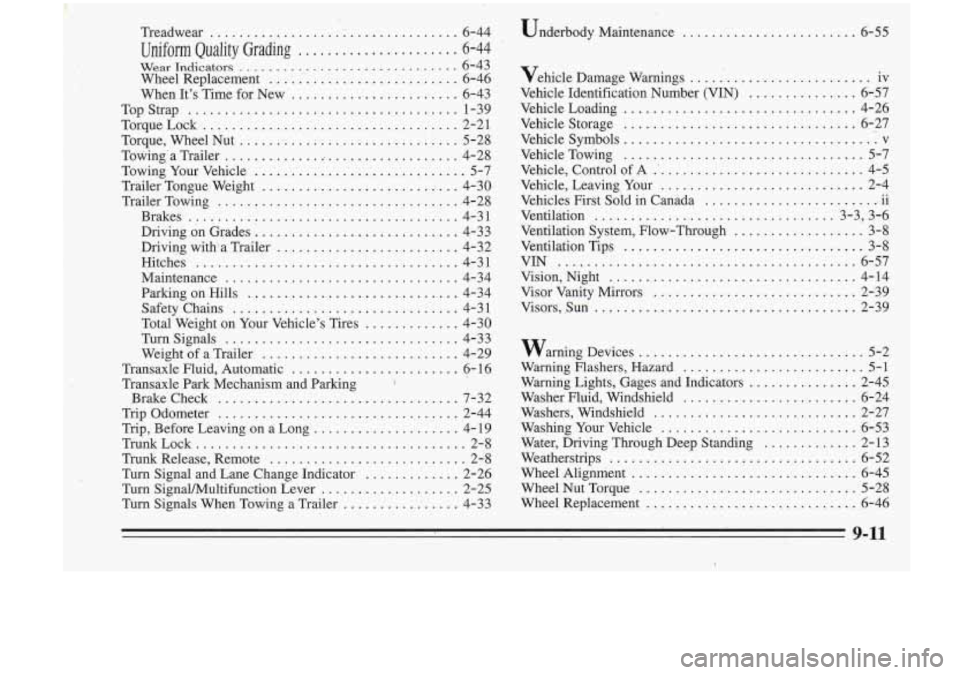
_- t
Treadwear .................................. 6-44
Uniform Quality Grading .................... . 6-44
wear Indicators .............................. 6-43
Wheel Replacement
.... .- ..................... 6-46
When It's Time for New
....................... 6-43
Top.Strap
..................................... 1-39
Torque, Wheel Nut
............................. 5-28
Towing'a Trailer
................................. 4-28
Towing Your Vehicle
.............................. 5-7
Trailer Tongue Weight'
............................ 4-30
Trailer Towing
................................. 4-28
Brakes
..................................... 4-31
Driving on Grades
............................ 4-33
Driving with'a Trailer
......................... 4-3.2
Hitches
.................................... 4-31
Maintenance
................................ 4-34
ParkingonHills
............................. 4-34
Safety Chains
............................... 4-3 1
Total Weight on Your Vehicle's Tires
.............. 4-30
Turn Signals
................................ 4-33
Weight of a Trailer
........................... 4-29
Transaxle Fluid, Automatic
....................... 6- 16
Transaxle Park Mechanism and Parking
I
Brake Check ................................... 7-32
Trip Odometer
................................. 2-44
Trip, Before Leaving on a Long
.................... 4- 19
TrunkLock
..................................... 2-8
Trunk Release, Remote
........................... 2-8
Turn Signal and Lane Change Indicator
............. 2-26
Turn SignaUMultifunction Lever
.................... 2-25
Turn Signals When Towing a Trailer
................ 4-33
TorqueLock
................................... 2-21
......
Underbody
Maintenance ........................ 6-55
Vehicle Damage Warnings
.... .................... iv
Vehicle Identification Number (VIN)
............... 6-57
Vehicle Loading
................................ 4-26
Vehicle Storage
................................ 6-27
Vehicle Symbols
................................... v
Vehicle Towing .................................. 5-7
Vehicle. Control of
A .............................. 4-5
Vehicle. Leaving. Your
............................ 2-4
Vehicles First Sold in Canada
11
Ventilation ................................. 3-3. 3-6
Ventilation System. Flow-Through .................. 3-8
VentilationTips
................................. 3-8
VIN
......................................... 6-57
Vision. Night
.................................. 4-14
Visor Vanity Mirrors
............................ 2-39
Visors. .Sun
..................................... 2-39
.. .........................
warning Devices ............................... 5-2
Warning Flashers. Hazard
......................... 5-1
Warning Lights. Gages and Indicators
............... 2-45
Washer Fluid. Windshield
................... - ....... 6-24
Washers. Windshield
............................ 2-27
Washing Your Vehicle
........................... 6-53
Water. Driving Through Deep Standing
............. 2-13
Weatherstrips
.................. ............... 6-52
Wheel' Alignment
............................... 6-45
WheelNutTorque
.............................. 5-28
Wheel Replacemept
............................. 6-46
9- 11